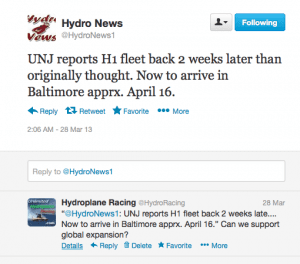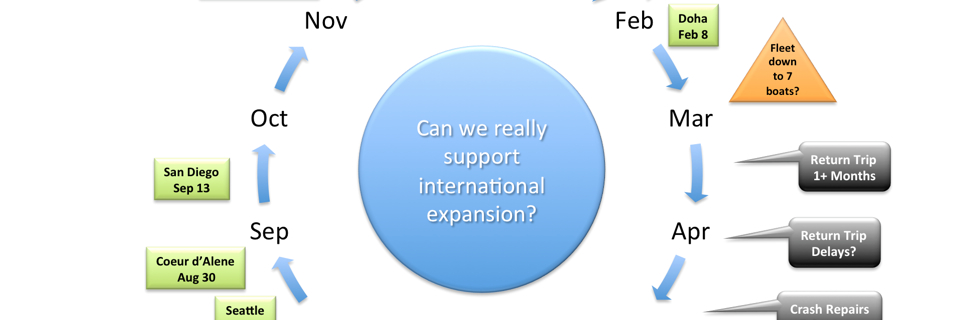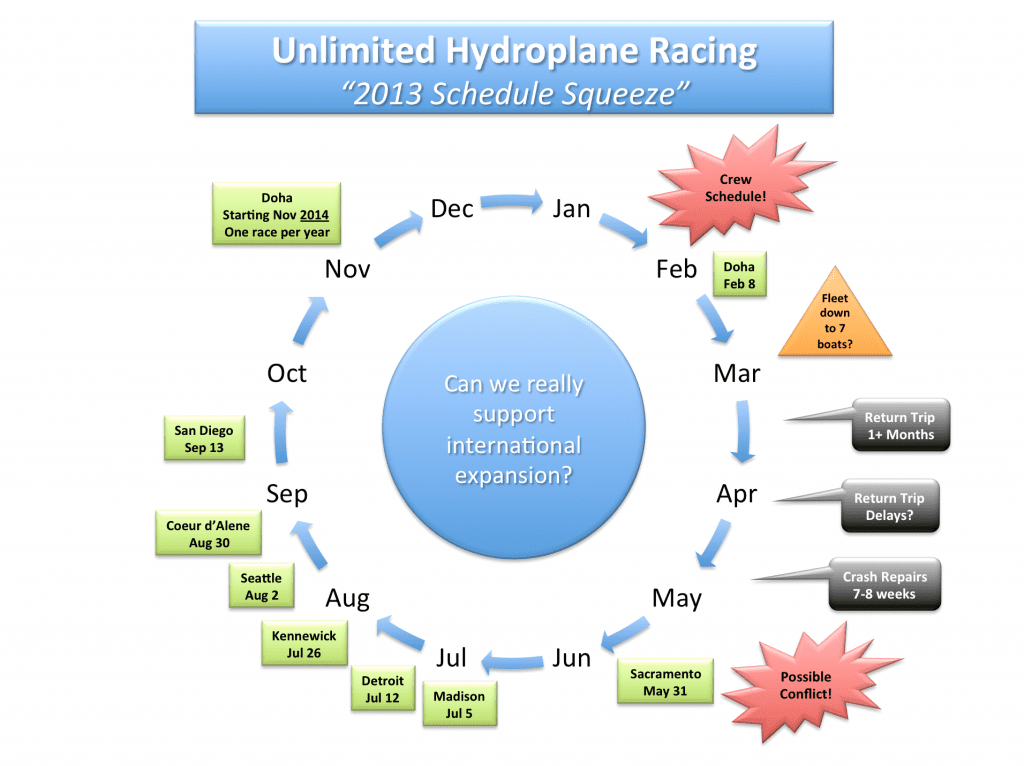Unlimited Hydroplane Racing Schedule Squeeze
“Is the calendar getting too full to properly support international expansion?”
This is a question that has been plaguing me lately, in spite of it being quite some time since there’s been any mention of a China expansion in the news. Even H1 hasn’t posted anything in over a year.
With the latest report of a delay in the fleet returning from Doha – a two week delay – I decided to take a look at how the calendar is filled and where the opportunities and challenges lie.
First, a hat tip to a Hydro News Tweet for getting the delay on my radar. Of course, I weighed in with a brief question and then decided to explore further.

Hydro News was reporting on a story in the March 2013 edition of the Unlimited News Journal Newsletter. In that HydroFile story by Lon Erickson, he cites the following:
“The original schedule had the H1 fleet returning approximately the first week of April into the Port of Houston. Now due to changes in the vessel Bahri Abha‘s route and time spent in ports of call, the schedule has fallen out of the original plan. Accommodations have now been made for the ship to unload the H1 fleet in Baltimore, MD. with an ETA of April 16th.”
Thank you to the Unlimited News Journal as well.
Schedule Squeeze
The first part of this analysis involves taking a look at how each calendar year is utilized in the sport of Unlimited Hydroplane Racing. We of course have a specific summer season in the U.S. to enjoy water sports, so it makes sense to have what appears to be back-to-back-to-back races.
Moving boats up and down the Interstate Highway System (or more officially, the Dwight D. Eisenhower National System of Interstate and Defense Highways) is a reasonable expectation. In spite of what at times are tight schedules, our open highways facilitate efficient and usually damage-free movement. Thanks, Ike!
With Doha in recent years tucked nicely in the middle of our winter, it provided a good escape to warmer climes (just when we need it.) By being scheduled in a period of time where good transport “buffer time” exists before AND AFTER the race, teams have had ample opportunities to make repairs from race damage, or from damage incurred on the high seas.
It happens.
One hanging curve ball this past year was the challenges posed by back-to-back Doha races late last year, and then right away again in February. Travel, volunteer crew scheduling and a host of other issues made it tough, but our teams worked through it.
Fortunately, this year’s February 8 Doha event will move to November of 2014, going back to a single event, ending the season, instead of this year’s starting it.
That will help.
Before we go any further, let’s take a look at the current calendar. To help me get my head around the travel pressures “enjoyed” by the teams, I created the following diagram:
In an attempt to stay away from a hair-splitting exercise, I’ve tried to keep it somewhat high-level, but you get the idea. On the right side of course, is where we are currently in early April.
This gives us a reference for further discussion about further expansion.
Is China Feasible?
Let’s assume Doha’s return to the end of the season is a good move to allow considerable time to get boats back, repaired and readied for the U.S. season. Given the delays we’ve just experienced and what this diagram shows to be a possible conflict before Sacramento, where would China be placed?
Sure, part of the potential conflict comes from the second Doha race February 8 and I just cited it being a one-race venue in November in the future. My concern is the same concern many of us had when there were two Doha races back-to-back. By moving back to a one-per-year schedule for Doha, adding a China venue may put us back into the same… er… ah… well… boat.
Doha’s back-to-back wasn’t a reflection on Doha, but instead a commentary on the challenges it placed on the volunteer-heavy teams. Taking vacation time from the day job is one thing, but to do it twice in a row, or take an extended absence to stay put is quite another.
I’m beginning to be concerned about teams leaving Doha for somewhere in China, and then be back in the same scheduling squeeze we are threatened with this year.
This concern opens Pandora’s box of many rhetorical questions. Here’s just a few:
- With boats being rebuilt, are race venues in danger of not fielding the minimum boat counts?
- Some teams have backup boats, but will that become the ante to play for everyone?
- Can this schedule cripple the U.S. season?
Strength From Within
It would be unusual to hear from any fan that sound, strategic expansion wouldn’t be a good move for the sport. Growth in the fan base, growth in attendance and growth in TV opportunities is nothing but good. Look at the good work Doug Miller has done with the Diamond Cup in Coeur d’ Alene this Labor Day weekend. Think about the progress Frantz Keintz is making to initiate a race on Lake Dardanelle in Arkansas.
These are talented, hardworking individuals who know their local areas and are building events that will be boons to their local communities, both for recreation and economic purposes. Once could argue this could be the best form of expansion we have available to us.
For those of you with a lot more experience at this, your perspectives would be very valuable to all fans. Is this a reasonable way to look at international expansion? Are the challenges worth the risks? Maybe we should look at simply extending the U.S. season and leave Doha as our only international race.
What are your thoughts?
How would you organize the calendar?
Dave



